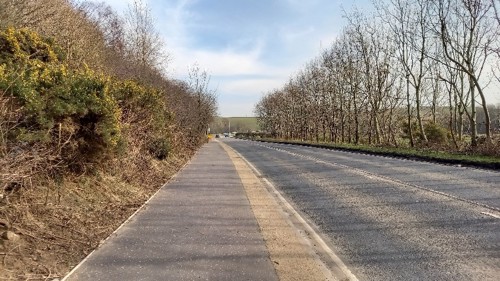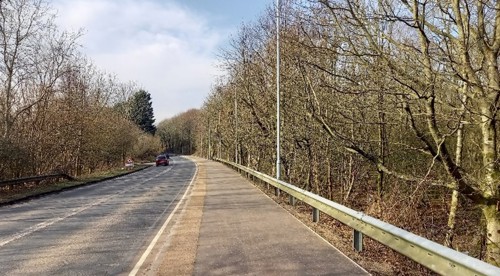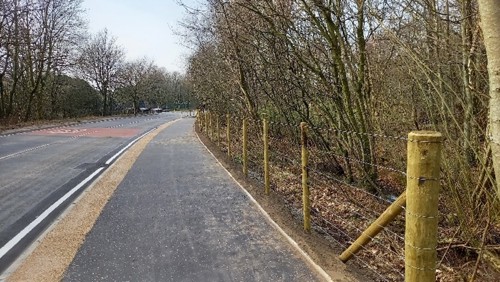A807 Active Travel Corridor
This consultation is now closed.
Thank you to everyone who took the time to fill in the survey. We have collated and analysed your responses below.
To follow the progress of this project please visit the A807 Active Travel Corridor Project page.
Background to Consultation
Section 1a – Works completed
The construction phase of Section 1a has now been completed following a four-month delivery programme.
The works, which were funded by Tier 1 and Tier 2 of Transport Scotland’s Active Travel Infrastructure Fund, included widening the existing footway by utilising the existing grass verge, replacing the existing kerbing along the front of the footway, and junction improvements at Dowan Road including the installation of street lighting.
The before and after images below illustrate the positive impact the works have had.
Before



After




Delivery of remaining sections
The Council is continuing to work with consultants, Sweco to produce a detailed design for Section 1b which will involve continuing the route from Section 1a to Milngavie railway station.
In addition, the Council is in the process of procuring a consultant to lead on delivering a detailed design for Sections 2 and 3.
The combined work on producing detailed designs for remaining sections will deliver a pipeline of construction phases for which the Council will aim to secure external funding to deliver in future years.
Further information on the background to the project and concept designs for all sections of the route can be found below and within the various attachments which can be downloaded.
Project Background
The Council is committed to improving active travel (e.g., walking, wheeling and cycling) infrastructure across East Dunbartonshire as set out within the Active Travel Strategy 2015-2020 and the Local Transport Strategy 2020-2025.
Actions within both strategies include an aspiration to create a circular route connecting the majority of the settlements in East Dunbartonshire, plugging existing gaps. It was identified that one major gap was an east-west connection and therefore an action was included to investigate the feasibility of delivering an active travel connection alongside the A807 between Torrance and Milngavie.
2022 Feasibility Study
In 2022, the Council, supported by funding from Transport Scotland, commissioned Sweco to undertake a feasibility study on options for delivering this connection. The study considered options for creating an off-road route, and a route alongside the current road corridor. The option alongside the A807 was deemed to be the best way forward and the study assessed the feasibility of delivering the route, considering a number of opportunities and constraints.
Concept Designs
Building on the work undertaken in 2022, the Council, supported by funding from Transport Scotland and Strathclyde Partnership for Transport (SPT), recommissioned Sweco, to undertake further design works on the project – building on the project aim, which is set out below:
Increase the number of active travel journeys in the area by making it safer and more enjoyable to travel by walking, wheeling and cycling between Torrance and Milngavie, improving pedestrian connectivity within the villages and providing onward connections to Bearsden, Bishopbriggs and beyond.
Concept designs have been produced which show proposed improvements across the route. The concept designs showcase proposals at this stage as the final designs will be subject to change depending on several key factors. The concept designs have been split into three sections, these are:
- Section 1 – Milngavie railway station to Allander Toll roundabout
- Section 1a - Location plan
- Section 1a - Dowan Road junction arrangement
- Section 2 – Allander Toll roundabout to Balmore (Glenorchard Road)
- Section 3 – Balmore (Glenorchard Road) to Torrance roundabout
The concept designs focus on delivering the following, closely following national design guidance included within Cycling by Design:
- A 2.5 metre wide shared-use footway alongside the A807 road corridor for most of the route (wider where space allows) to be used by those walking, wheeling (e.g. travelling by wheelchair, mobility scooter) and cycling
- A 0.5 metre buffer zone between the carriageway and shared-use footway
- A standard speed limit of 30mph for the entire route
- New signalised crossings and improvements to junctions (such as reduced junction radii, lighting, dropped kerbs and tactile paving) aiming to facilitate safer onward travel across the route as well as improving pedestrian connectivity within Torrance, Balmore and Bardowie.
The final concept designs for each section can be downloaded from the documents section on this page.
Further information on the background work involved in the concept design stage can be viewed within the project Story Map or in the Concept Design Report available to download from the documents section of this webpage which was prepared for the public consultation held on the project.
Consultation
Over February and March 2024, the Council sought views of local communities and users of the route on the proposals set out within the concept designs. Over 300 people responded to the survey during that time, with over 140 people attending drop-in sessions held in Milngavie, Balmore and Torrance. Two-thirds of respondents were supportive of the aim of the project, with 54% stating their strong support. 30% did not support the aim, with 20% strongly against. More detailed information on the results of the consultation can be viewed within the Concept Design Report available to download from the documents section of this webpage.
Further information
Project updates will be published here when they become available. If you have specific queries you can contact A807Project@eastdunbarton.gov.uk
Offices will endeavour to respond as quickly as possible, but please note this will be dependent on the nature of the enquiry and the number of enquiries we are receiving.
Thank you.
